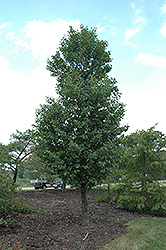Pyramidal Common Alder
Alnus glutinosa 'Pyramidalis'
Height: 50 feet
Spread: 15 feet
Sunlight:
![]()
![]()
Hardiness Zone: 4
Other Names: Black Alder, European Alder
Description:
A strongly columnar tree, makes an exclamation point in the landscape, good for screening or formal tall hedges; best used for specific applications in the landscape
Ornamental Features
Pyramidal Common Alder is primarily valued in the landscape for its rigidly columnar form. It has dark green deciduous foliage. The oval leaves do not develop any appreciable fall color.
Landscape Attributes
Pyramidal Common Alder is a deciduous tree with a narrowly upright and columnar growth habit. Its average texture blends into the landscape, but can be balanced by one or two finer or coarser trees or shrubs for an effective composition.
This is a relatively low maintenance tree, and should not require much pruning, except when necessary, such as to remove dieback. It has no significant negative characteristics.
Pyramidal Common Alder is recommended for the following landscape applications;
- Accent
- Vertical Accent
Planting & Growing
Pyramidal Common Alder will grow to be about 50 feet tall at maturity, with a spread of 15 feet. It has a low canopy with a typical clearance of 4 feet from the ground, and should not be planted underneath power lines. It grows at a fast rate, and under ideal conditions can be expected to live for 50 years or more.
This tree does best in full sun to partial shade. It is quite adaptable, prefering to grow in average to wet conditions, and will even tolerate some standing water. It is not particular as to soil type or pH. It is somewhat tolerant of urban pollution. Consider applying a thick mulch around the root zone in winter to protect it in exposed locations or colder microclimates. This is a selected variety of a species not originally from North America.
